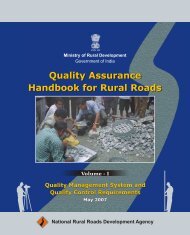Grameen Sampark Final April 0... - pmgsy
Grameen Sampark Final April 0... - pmgsy
Grameen Sampark Final April 0... - pmgsy
You also want an ePaper? Increase the reach of your titles
YUMPU automatically turns print PDFs into web optimized ePapers that Google loves.
20<br />
A maximum of 50mm rut depth was recommended for<br />
the unpaved roads. The reliability adopted is 50%.<br />
Asphalt Institute [5] adopted the following subgrade<br />
strain criteria<br />
<br />
Where,<br />
<strong>Grameen</strong> <strong>Sampark</strong><br />
-2 <strong>0.</strong>223<br />
= 1.05*10 *[1/N] (5)<br />
N = No of 80 kN equivalent single axle loads;<br />
<br />
Z<br />
Z<br />
= Vertical subgrade strain ( micro strain) at<br />
top of the subgrade layer<br />
TRRL [6] considers the following relationship to<br />
complete allowable subgrade strains for 85 percent<br />
probability of survival to a design life of N repetitions of<br />
o<br />
80kN axle and a pavement temperature of 20 C.<br />
Log (N) = -7.21-3.95* log ( ) (6)<br />
Z<br />
The failure condition considered for the above criteria is<br />
rutting of 20 mm<br />
The Shell [7] design method uses the following<br />
subgrade strain for different confidence levels:<br />
-2 -<strong>0.</strong>25<br />
50% confidence = 2.8*10 *N (7)<br />
Z<br />
-2 -<strong>0.</strong>25<br />
85% confidence = 2.1*10 *N (8)<br />
Z<br />
-2 -<strong>0.</strong>25<br />
95% confidence = 1.8*10 *N (9)<br />
Z<br />
A terminal value of percent serviceability (PSI) of 2.5<br />
was taken as failure condition.<br />
Indian Road Congress (IRC 37:2001) [8] adopted the<br />
following performance criteria for high volume roads.<br />
N R =<br />
-8 4.5337<br />
4.1656*10 [1/ Z ] (10)<br />
N R = Number of cumulative standard axels to<br />
produce rutting of 20 mm.<br />
<br />
Z<br />
= Vertical subgrade strain (micro strain).<br />
Development of an average rut depth of about 20 mm is<br />
considered to be failure in rutting mode.<br />
IRC:SP:20:2002 [9] is for design of low-volume rural<br />
roads in India. The criterion for determining the<br />
thickness of a flexible pavement with a thin bituminous<br />
surfacing is the vertical compressive strain on top of the<br />
subgrade imposed by a standard axle load (80kN). The<br />
maximum rutting allowed is 50mm before any<br />
rehabilitation work is taken up. The design charts have<br />
reportedly been prepared as per Road Note 29 of TRL,<br />
IRC: 37 and other related experiences in India. No<br />
mechanistic rutting criterion has been proposed<br />
correlating the design life with subgrade strain or any<br />
other parameter.<br />
Mohanty et al [10] studied the performance of 59 village<br />
road sections in Orissa and proposed some design<br />
charts for construction of new low-volume rural roads.<br />
The pavement condition data collected on these<br />
sections were correlated with mechanistic response of<br />
the pavement to develop a performance criteria based<br />
on limiting rutting value.

















